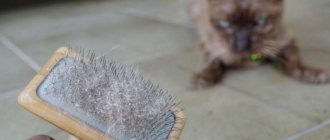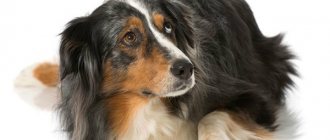Allergic reactions
The immune system protects the dog's body from foreign proteins. Immunocompetent cells compare their own and proteins received from outside. If an intruder is detected, a violent inflammatory reaction occurs that destroys the enemy.
The body of an allergy sufferer mistakes some relatively harmless compounds for harmful ones. Dermatitis occurs, accompanied by itching (pruritis), hair loss. Dogs react violently to food, certain foods, household chemicals, shampoos, pollen, and nematode toxins.
The dog's hair is falling out
Causes
Itching and hair loss in dogs can be caused by the following reasons:
- Ectoparasites. These are parasites that live on the animal's body and can cause itching and hair loss. Ectoparasites cannot always be seen with the naked eye.
- Infectious diseases. An animal can get similar diseases just by walking outside. They are completely different and often difficult to distinguish from each other. Treatment of all infectious diseases is quite simple in the first stages. If the disease is advanced, then there is a high risk of serious complications and even death of the animal.
- Allergy. Allergies in animals, like in people, can be caused by one or another irritant. Most often this is associated with food. Determining the cause of an allergy on your own can be difficult, so it is recommended to consult a specialist.
These are the three main reasons why dogs may experience itching and hair loss. It is necessary to understand that each of these points includes a huge variety of different diseases or irritants.
Let's now try to take a closer look at the most common cases that are characterized by similar symptoms, and also figure out how to deal with such problems.
Fleas in the litter
It is very common for dogs to itch after flea treatment. For example, a dog picked up fleas on the street and fought them with shampoos. In this case, in the near future, fleas will not be able to live on the animal’s body. The problem may be that the dog has fleas in the bedding or kennel.
If the dog lives outside in a kennel, then it also needs to be treated with special products (which are sold in veterinary pharmacies) or washed well with detergents.
Allergy
Hair loss and itching can often be caused by an allergic reaction in your dog. Most often this is associated with food. This can be noticed and understood in cases where a pet begins to eat something it did not eat before (for example, other food). In this case, you need to change your diet.
But things are not always so obvious. Sometimes, to find out the cause of the allergy, it is necessary to contact a veterinary clinic. There they will take tests from the animal and be able to determine what caused the allergic reaction. Subsequently, the owner will be announced the results and given a list of what causes the allergy.
Ectoparasites
It is quite difficult to notice ectoparasites on your own. These are small creatures that bother your pet no less than fleas. There are two main types of such parasites.
Scabies and lice
Scabies and lice bites are small, flesh-colored bugs that live on your dog's skin and fur. They most often affect puppies and older dogs. Young dogs are susceptible to such problems only in cases of weakened immunity.
This disease is characterized by scratching on the abdomen, elbows, inguinal folds and ears. The main symptoms are that the fur becomes brittle and dry, often matting. Dry crusts or scales can also be found on the skin.
Trombiculide and demodicosis
Similar problems are caused by tick larvae in dogs. Diseases manifest themselves quite clearly and it is very difficult not to notice them. The skin around the eyes and near the mouth is most often affected. It becomes red, hair falls out in these places, and the skin becomes covered with pustules in these places.
These parasites also settle on the stomach and groin area. In these places, redness, hair loss and the formation of red crusts are also observed.
Insectoacaricidal drops are used to get rid of ticks. You can see reviews and instructions for using Bars drops against fleas and ticks on dogs in this article.
Fungus
Fungal diseases appear most often in dogs that have not been vaccinated or in animals with severely weakened immune systems. Such diseases are often dangerous and can be transmitted to humans.
The main symptoms of fungus are:
- severe itching;
- redness;
- receding hairline is round in shape.
For treatment, it is best to vaccinate or treat the dog with a special course of medications (tablets and injections). In addition, it is recommended to use special shampoos.
Fungal infections
Fungi live on your dog's skin all the time. They perform the function of balance between microorganisms. The immune system regulates the proliferation of microbes, ensuring a symbiotic relationship. When the balance is disturbed, micromycetes are activated and begin to rapidly multiply, using skin and wool as substrates. Dermatitis occurs, accompanied by itching and hair loss.
The appearance of the disease is facilitated by improper living conditions, insufficient or excessive care of the coat, and uncontrolled use of medications that destroy fungal antagonists. A group of diseases caused by micromycetes is collectively called ringworm. The most common pathogens are trichophyton, microsporum, and malassezia fungi.
Lichen
The dog is itching
Posted by Domsobaki · October 16, 2016
It is not uncommon for a dog or puppy to itch or act strangely for no apparent reason. In such a case, you should immediately go to an experienced veterinarian at a veterinary clinic, since the problem can be so serious that the person will also suffer, and in this case, no home treatment can quickly help sort out the situation.
It will also not be superfluous to ask questions in the comments and describe similar problems, as well as how you managed to cope with them, because there may be many similar cases, but for the most part they will have similarities, and therefore a similar solution.
What to do if your dog itches but there are no fleas and why he chews himself, dandruff, how to treat it
The cause of itching in dogs in the absence of fleas can be dandruff. The appearance of dandruff in animal hair, in turn, can be associated with: - seasonal shedding and excessive dryness of the animal’s skin; — the presence of hair mites and other parasites invisible to the eye; - food allergies; - hormonal imbalance in the body; - dermatitis, diabetes, eczema and other ailments.
It is necessary to treat dandruff in dogs only after eliminating the cause of its occurrence, for which you will need to have the animal examined by a veterinarian and, if necessary, undergo a course of treatment - the use of shampoos or other external dandruff remedies alone will not give the desired effect.
The dog itches, hair falls out, fleas, no ticks, no how to cure, how to treat
Dog hair loss is usually associated with shedding. Other equally common reasons for this phenomenon are: - food allergies; — allergies to external animal care products; - reaction to medications; - consequences of stress - separation from the owner, postoperative period and a number of other circumstances.
The approach to treating a dog depends on the reasons that caused the unwanted reaction in the animal’s body. Sometimes veterinarians recommend a course of treatment with antibiotics or immunomodulatory drugs, and sometimes a simple change of environment is enough.
The dog itches until it bleeds, wounds, scabs, sores, what is the diagnosis and how to treat
The most common causes of itchy and bleeding sores on the skin of dogs are ringworm and scabies. Both diseases can be transmitted from a sick animal to humans, so this problem must be approached quite seriously. Self-medication or delaying a visit to doctors often only aggravates the situation, and the cure is more difficult.
The dog is very itchy after flea and tick drops, bathing, or haircuts
Itching that occurs in a dog immediately after using flea and tick drops is normal and is caused by dying parasites. In rare cases, the animal’s body reacts in this way to the active ingredient of the drug itself. In this case, the dog should be washed well and given an antihistamine.
If your dog is itching after bathing, then most likely it is an allergic reaction to the components of the shampoo. You should know that special detergents have been developed for animals and you should not wash dogs with soap or shampoo intended for humans.
Irritation and itching of the dog's skin after a haircut is most likely caused by non-compliance with hygiene measures - using dirty and undisinfected scissors and clipper knives, cutting an unwashed animal, etc.
The dog itches and goes bald, allergies, how to treat folk remedies
You can cope with allergies in a dog only by eliminating the allergen itself. The product that caused a painful reaction in the body is determined empirically - the animal is put on a diet, adding a new product to its daily diet and monitoring the reaction caused by its use.
In addition to food, a dog may be allergic to insecticides, medications, various chemical compounds and insect bites. A popular way to treat allergies is to drink tea from a herbal mixture consisting of string, elecampane, wheatgrass rhizomes and chamomile with sage.
The dog is itching, can you give suprastin and it doesn’t help, what should you give at home?
Suprastin is one of the universal antihistamines that are prescribed to relieve allergy symptoms in both humans and animals.
In addition to Suprastin, a veterinary clinic can prescribe fenistil, bravegil, tavegil, Claritin, Zyrtec and other drugs available in pharmacies for humans, as well as soothing herbal teas of chamomile, sage, wheatgrass rhizomes and string.
The dog itches during molting, estrus, in the heat, in the area of the tail and chews out the hair near the tail
Dogs scratching while shedding is normal. Thus, the animal helps itself to get rid of dead hairs. “Scabies” during estrus is associated with stress experienced by the dog, which, like shedding, can cause death and hair loss.
Itching that occurs in the heat is associated with increased activity of microbes and bacteria. The slightest scratch can cause the dog to develop necrosis. The most likely cause of a dog chewing out its fur in the tail area is fleas and helminths.
Dog itches red spots on belly, rash
Itchy red spots and rashes on your dog's belly can be caused by: - food allergies; - fungal disease; - flea or tick bites.
Only a veterinarian can make a final verdict, and then only after examining and examining the animal.
The dog itches its butt on the floor, its muzzle
The probable reasons that a dog itches its butt on the floor are: - the presence of flatworms; - allergic reaction; - pain in the lower back; - clogged anal sacs (paraanal glands).
Microscopic insects, lice, fleas, ticks and other living creatures can cause itching on the animal's face.
The dog itches from the flea collar, gets angry and whines when you stroke its sides, how to help
Flea collars are impregnated with an active substance that can cause an allergic reaction and even poisoning of the animal. If, when putting it on, the dog begins to itch continuously and its condition causes concern, then it is better to remove the collar.
If a dog, which previously did not express dissatisfaction with being stroked on the sides, begins to whine and gets angry when a person touches it in the same places, then it has problems with its health. To clarify all the circumstances, it is advisable for the animal to have an ultrasound or x-ray of the abdominal cavity.
- 5 Comments
- 0 Trackbacks & Pingbacks
There can be many reasons for such scratching. You need to keep an eye on your pet and if something happens, take it to the vet immediately
Subcutaneous mite
Baldness, accompanied by dermal pruritis, is caused by the activity of intradermal and subcutaneous mites. The first category includes demodexes, permanent inhabitants who cleanse the integument of dirt, desquamated epidermis, and secretions of the sebaceous glands. In dogs with weakened immune systems, arthropods multiply uncontrollably. They gnaw passages inside the skin, secreting ichor, which is a substrate for secondary microflora.
Demodicosis
The Sarcoptes mite penetrates the skin from the outside, and if the dog’s immunity is weakened by some concomitant disease, it causes a pathological condition called classic scabies. Notoedrus affects primarily the outer surface of the ears, spreading in severe cases to the entire body. Otodectes also parasitize the organs of hearing, only from the inside.
How to treat?
When getting rid of itching in a dog, the most important condition for recovery is determining the cause of the condition. First of all, doctors recommend using broad-spectrum preventive treatments that affect most types of ectoparasites. For example, Advocate drops, Stronghold, Bravecto tablets, etc.
The next step is to interrupt the itching mechanism. On a physical level. Drugs such as Prednisolone, Apoquel, medicated shampoos or ointments similar in action can cope with this.
After removing the irritation, it is imperative to determine the causes, otherwise the itching will return immediately after stopping the medications. This could be a change in diet, treatment of a bacterial or fungal infection, or improvement of the functioning of individual body systems.
In each case, the dermatologist selects a treatment regimen individually, depending on the clinical picture and the results of blood tests and skin scrapings.
Prevention
Treatment for each type of disease is specific. And the methods of prevention are the same. They consist of the following activities:
- Comfortable living conditions.
- Complete nutrition.
- Regular disinsection and deratization.
- Grooming.
- Avoid bathing dogs with detergents.
- Routine vaccinations against particularly dangerous diseases. They stimulate the immune system as a whole.
The appearance of the skin indicates the health of the dog. To prevent your pet’s hair from falling out and its skin from itching, you should adhere to the rules of keeping, feeding and care. If patches of baldness and signs of itchy skin are detected, you should seek veterinary help.
We invite you to join our Zen channel and group on VKontakte or Odnoklassniki, where new articles for pet owners are published.
Similar articles:
- A dog has bleeding after giving birth - what could it be and what should I do?
- Dog has bleeding after giving birth
- Puppy sniffles
Possible causes of hair loss in dogs
The coat is very important for a dog, but certain factors can cause hair loss. A dog sheds on average twice a year; this is normal.
Dog hair loss occurs for various reasons.
However, if the dog’s hair falls out in large clumps, bald spots remain on the dog, and it becomes almost bald, then you should consult a veterinarian. There are several factors that can lead to bald spots appearing on a dog.
Hormonal disorders in the body
Hormonal problems in dogs are most often associated with genetic disorders. Such phenomena have not been fully studied. Hormonal imbalance can also occur under the influence of external factors.
Most often, the main causes are the following diseases:
- hypothyroidism – there is a lack of production of thyroid hormones;
- hyperandrenocorticism – increased cortisol levels.
Excessive amounts of estrogen can also cause baldness in dogs, with quite a lot of hair falling out in the genital area. With a lack of this hormone, hair begins to fall out gradually - first around the genitals and anus, and then throughout the body (females are more likely to suffer).
The coat suffers due to a lack or excess of hormones
Poor nutrition
Baldness in a dog can be caused by poor diet, which lacks essential vitamins and minerals. Most often dogs that are fed the same natural diet are most often affected. Pets need vitamins B and C to maintain good coat condition.
Inexpensive dry and wet food also does not contain the required amount of nutrients, which is why the dog develops bald spots on its body.
Normal seasonal shedding
Seasonal shedding occurs twice a year, but in some breeds it may occur more often. It is important to monitor the dog during this period and brush it regularly.
You can distinguish molting from baldness by several signs:
- Hair falls out evenly, leaving no bald spots.
- After combing, new hair of shorter length is noticeable.
- Loss occurs seasonally.
- The pet's behavior and condition have not changed.
In some cases, the dog may itch a little when changing coats, but this does not happen all the time.
Attention! To alleviate the dog's condition, it is recommended to brush it regularly.
It is important to distinguish seasonal shedding from baldness
Parasites
The presence of parasites negatively affects the general condition of the dog. Pests can settle both on the skin and on internal organs. Parasites provoke deterioration of the hair follicles, resulting in bald spots on the elbows of the paws.
Pests often cause severe itching in the animal. The pet often itches a lot, and the fur begins to fall out in pieces. This condition can be caused by fleas, ticks, lice eaters, and various helminths.
Important! Diseases can occur in dogs of any breed - shepherds, sharpeis, bull terriers and other dogs with a weak immune system.
Stress
Animals are no less susceptible to stress than humans. As a result, the dog experiences a rather strong negative reaction, which can cause hair loss. Stress in a dog can be caused by a change of place of residence, visiting unfamiliar places with large crowds of people, aggressive behavior on the part of people and other animals.
Due to stress, a dog develops the simplest form of baldness – diffuse. As a rule, unpleasant symptoms go away on their own and do not require any measures. However, if stress is repeated frequently, the problem may worsen.
Stress often leads to hair loss
Non-hormonal
Non-hormonal causes include solar dermatitis, in which hair falls out mainly on the nose. The problem is quite dangerous because it can lead to the appearance of ulcerative skin lesions, and the nose near the eyes begins to peel off.
A disease such as “blue Doberman syndrome” - color mutation alopecia - also does not depend on hormones. Hair falls out heavily all over the dog's body (on the front and back legs, belly). In most cases, it is Dobermans who suffer from the disease.
Other diseases:
- Vitiligo is a disease in which the dermis loses its color, as a result, the hair begins to fall out intensively, and bald spots form on the dog. The most common problem is the head. Rottweilers and Belgian terriers have a similar problem.
- Adenitis of the sebaceous glands is a disease in which a dog’s face, head, back and neck, and abdomen become symmetrically bald. Poodles are most often susceptible to this disease.
- Acanthosis nigricans is a disease that causes severe hair loss in the pet's armpits and ears. At the same time, these places begin to smell intensely. Dachshunds most often suffer from this disease.
Various infectious diseases
Infections can also trigger the development, such as ringworm. This disease is also dangerous because the animal can infect its owner. The disease is provoked by a fungus, as a result of which hair constantly falls out in areas with high humidity, they begin to smell unpleasant, and the oiliness of the skin increases.
Baldness can affect different parts of the body
Contact or food dermatitis
Such dermatitis occurs as a result of allergic reactions in a dog to food or upon contact with any substances. In this case, baldness is associated with a constantly recurring reaction.
Allergies can be caused by food, plants, and various clothing materials. As a result, dry skin is noted, and the pet begins to constantly scratch some places. Dandruff may appear, and a bald spot may form on the dog’s back.
Important! To determine the cause of the allergic condition, you will need the help of a specialist.
How to treat flea dermatitis
So how to cure flea dermatitis in dogs? We've found that if your dog is itching, the first thing to rule out is fleas (and other external parasites). You can drive away parasites with the help of special drugs. But treatment of flea dermatitis in dogs must be comprehensive. In addition to destroying parasites, it is equally important to relieve the symptoms of flea allergy by eliminating itching and inflammation of the dog’s skin. Indeed, even after all the fleas have died, symptoms can persist for a month or even longer, seriously reducing the quality of life of the animal and its owner. This is due to the fact that as soon as the flea’s saliva enters the dog’s bloodstream, a whole cascade of reactions is launched in its body aimed at eliminating this foreign poison. And this cascade can rage for quite a long time. Meanwhile, the dog will itch and itch, damaging its skin again and again. The longer you do not take measures to eliminate the consequences of bites, the more serious the skin damage can be.
The drug Apoquel successfully relieves the symptoms of flea allergy in dogs, starting to act from the first hours after giving the tablet. It can be used throughout the period while the reaction to flea bites manifests itself. But it is very important to use it in parallel with antiparasitic agents, because they eliminate the cause of flea allergies.
Talk to your veterinarian about how Simparica, Stronghold and Apoquel can help with flea dermatitis.
After all, if you take the proper precautions, your pet will not suffer any negative consequences due to flea bites. 1. Dryden MW, Payne P, Zurek L. Fleas Infesting Pets & Home, Kansas State University, September 2003
What does it mean if a dog doesn’t have fleas, but it itches often and very badly?
Obsessive scratching of a dog often causes a lot of discomfort, not only for the dog itself, but also for the owner.
There are various reasons that cause this behavior. Starting from the presence of ectoparasites, in other words, fleas and ticks, ending with various malfunctions of the body’s immune system.
Why is this happening?
Itching is not an independent symptom, but reflects pathological changes in the internal organs and systems of the body.
In addition to the main symptom of a number of skin diseases and the response to flea bites, the appearance of this sensation may indicate damage to the nervous system, digestive organs, diseases of the endocrine system, liver, and oncology.
Also, the itching reflex quickly becomes established in the subcortex of the dog’s brain and, if a number of circumstances coincide, it can manifest itself in the form of obsessive behavior.
How can you be sure there are no parasites?
Adult fleas are dark in color, ranging from brown to almost black. When stroking a dog, they are quite easy to notice if the pet has short hair. Difficulties arise in detecting parasites on breeds with thick coats.
Favorite places for fleas to be found are the armpits, inguinal folds, and muzzle. In these places the body temperature is elevated and they are least susceptible to external factors. Looking at the fur, you can see flea eggs; they look like salt.
The skin will be irritated and red. Flea saliva is a strong allergen and sometimes a single bite is enough to cause severe itching. It is difficult to notice single specimens. Washing the dog will be indicative. Since fleas cannot breathe underwater, they will tend to move to dry areas.
Another way is to comb the fur with a special comb, after placing the pet on a white sheet. Fleas of contrasting color will either fall down onto the white or remain on the comb, but will be noticed either way.
There are indirect symptoms that should alert the owner:
- Restless behavior of a dog in a dream. She may change places frequently, moving several times a night.
- Nervousness and general irritability.
- Intense movements when scratching in the same place.
Constantly bites himself, but his skin is clear
Any skin disease accompanied by itching causes a change in the condition of the skin - this may be redness, swelling, hair loss, or the formation of crusts. But sometimes it happens that apart from itching there are no other symptoms. The skin remains bright and clean.
In this case, the cause of obsessive behavior is a psychological factor. Dogs are more susceptible to stressful situations than people, be it a long absence of the owner, a change of environment, fireworks on the street or something else that is traumatic or frightening.
Nervous excitement leads to destructive behavior. The pet may spin around, itch, or chew out places. At the same time, once the balance of the nervous system is established, the obsessive behavior disappears by itself.
Causes of red
Another situation is when itching is accompanied by redness of the skin.
Depending on the location and intensity of the color change, this may indicate various diseases:
- allergies of various etiologies (food, drugs), as well as atopic dermatitis;
- staphylococcal infection;
- contact dermatitis;
- hives.
Started whining
Sometimes the unpleasant sensations are so intense that they cause the dog to involuntarily whine along with attempts to scratch itself. The causes of this condition can be a variety of diseases.
For example, Aujeszky's disease causes such unbearable itching that the pet breaks the skin to the deep layers. Acute food intolerance or reaction to non-protein foods is accompanied by severe pain. Unproductive attempts to get rid of them lead to involuntary vocalization.
In any case, a detailed examination by a specialist is necessary in order to prescribe treatment.
How to treat?
When getting rid of itching in a dog, the most important condition for recovery is determining the cause of the condition. First of all, doctors recommend using broad-spectrum preventive treatments that affect most types of ectoparasites. For example, Advocate drops, Stronghold, Bravecto tablets, etc.
The next step is to interrupt the itching mechanism. On a physical level. Drugs such as Prednisolone, Apoquel, medicated shampoos or ointments similar in action can cope with this.
After removing the irritation, it is imperative to determine the causes, otherwise the itching will return immediately after stopping the medications. This could be a change in diet, treatment of a bacterial or fungal infection, or improvement of the functioning of individual body systems.
In each case, the dermatologist selects a treatment regimen individually, depending on the clinical picture and the results of blood tests and skin scrapings.
What should you do if you have treated it, but the itching still remains?
It happens that after treatment the itching not only does not disappear, but also noticeably intensifies. The reason lies in individual sensitivity to the components of the drug.
In this case, it is necessary to give the pet an antihistamine, for example Zertec, Suprastin, Tavegil in a dosage according to weight. Wash off the applied product with shampoo in warm water. The irritable reaction lasts from 1 to 4 days.











